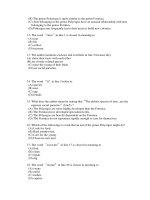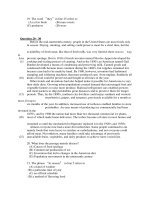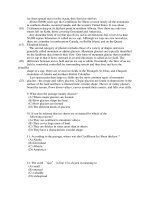kí năng đọc hiểu trong toeic 9 ppt
Bạn đang xem bản rút gọn của tài liệu. Xem và tải ngay bản đầy đủ của tài liệu tại đây (62.55 KB, 6 trang )
(B) extremely wealthy
(C) a member of the Continental Congress
(D) a famous writer
39. The word "position" in line 24 is closest in meaning to
(A) job
(B) election
(C) document
(D) location
Question 40-50
Galaxies are the major building blocks of the universe. A galaxy is a giant family of
many millions of stars, and it is held together by its own gravitational field. Most of the
material universe is organized into galaxies of stars, together with gas and dust.
Line There are three main types of galaxy ; spiral, elliptical, and irregular. The Milky
(5) Way is a spiral galaxy : a flattish disc of stars with two spiral arms emerging from its
central nucleus. About one-quarter of all galaxies have this shape. Spiral galaxies are
well supplied with the interstellar gas in which new stars form ; as the rotating spiral
pattern sweeps around the galaxy it compresses gas and dust, triggering the formation
of bright young stars in its arms. The elliptical galaxies have a symmetrical elliptical or
(10) spheroidal shape with no obvious structure. Most of their member stars are very old
and since ellipticals are devoid of interstellar gas, no new stars are forming in them.
The biggest and brightest galaxies in the universe are ellipticals with masses of about
1013 times that of the Sun; these giants may frequently be sources of strong radio
emission, in which case they are called radio galaxies. About two-thirds of all galaxies
(15) are elliptical. Irregular galaxies comprise about one-tenth of all galaxies and they come
in many subclasses.
Measurement in space is quite different from measurement on Earth. Some
terrestrial distances can be expressed as intervals of time : the time to fly from one
continent to another or the time it takes to drive to work, for example. By comparison
(20) with these familiar yardsticks, the distances to the galaxies are incomprehensibly
large,
but they too are made more manageable by using a time calibration, in this case the
distance that light travels in one year. On such a scale the nearest giant spiral galaxy,
the Andromeda galaxy, is two million light years away. The most distant luminous
objects seen by telescopes are probably ten thousand million light years away. Their
light was already halfway here before the Earth even formed. The light from the nearby
Virgo galaxy set out when reptiles still dominated the animal world.
40. The world "major" in line 1 is closest in meaning to
(A) intense
(B) principal
(C) huge
(D) unique
41. What does the second paragraph mainly discuss?
(A) The Milky Way
(B) Major categories of galaxies
(C) How elliptical galaxies are formed
(D) Difference between irregular and spiral galaxies
42. The word "which" in line 7 refers to
(A) dust
(B) gas
(C) pattern
(D) galaxy
43. According to the passage, new stars are formed in spiral galaxies due to
(A) an explosion of gas
(B) the compression of gas and dust
(C) the combining of old stars
(D) strong radio emissions
44. The word "symmetrical" in line 9 is closest in meaning to
(A) proportionally balanced
(B) commonly seen
(C) typical large
(D) steadily growing
45. The word "obvious" in line 10 is closest in meaning to
(A) discovered
(B) apparent
(C) understood
(D) simplistic
46. According to the passage, which of the following is NOT true of
elliptical galaxies?
(A) They are the largest galaxies.
(B) They mostly contain old stars.
(C) They contain a high amount of interstellar gas.
(D) They have a spherical shape
47. Which of the following characteristics of radio galaxies is mentioned
in the passage?
(A) They are a type of elliptical galaxy.
(B) They are usually too small to be seen with a telescope
(C) They are closely related to irregular galaxies.
(D) They are not as bright as spiral galaxies.
48. What percentage of galaxies are irregular?
(A) 10%
(B) 25%
(C) 50%
(D) 75%
49. The word "they" in line 21 refers to
(A) intervals
(B) yardsticks
(C) distances
(D) galaxies
50. Why does the author mention the Virgo galaxy and the Andromeda galaxy
in the third paragraph?
(A) To describe the effect that distance has on visibility
(B) To compare the ages of two relatively young galaxies
(C) To emphasize the vast distances of the galaxies from Earth
(D) To explain why certain galaxies cannot be seen by a telescope
Test 5
Question 1-8
A distinctively American architecture began with Frank Lloyd Wright, who had
taken
to heart the admonition that form should follow function, and who thought of buildings
not as separate architectural entities but as parts of an organic whole that included the
Line land, the community, and the society. In a very real way the houses of colonial New
(5) England and some of the southern plantations had been functional, but Wright was the
first architect to make functionalism the authoritative principle for public as well as for
domestic buildings.
As early as 1906 he built the Unity Temple in Oak Park, Illinois, the first of those
churches that did so much to revolutionize ecclesiastical architecture in the United
(10) States. Thereafter he turned his genius to such miscellaneous structures as houses,
schools, office buildings, and factories, among them the famous Larkin Building
in Buffalo, New York, and the Johnson Wax Company Building in Racine, Wisconsin.
1. What does the passage mainly discuss?
(A) The architecture of public buildings
(B) An architectural pioneer
(C) New England architecture
(D) principles of architecture
2. The phrase “taken to heart” in lines 1-2 is closest in meaning to which
of the following?
(A) Taken seriously
(B) Criticized
(C) Memorized
(D) Taken offence
3. The word “admonition” in line 2 is closest in meaning to
(A) monition
(B) support
(C) discussion
(D) consideration
4. The word “entities” in line 3 is closest in meaning to
(A) principles
(B) existences
(C) subtractions
(D) properties
5. In what way did Wright's public buildings differ from most of those
built by earlier architects?
(A) They were built on a larger scale.
(B) Their materials came from the southern United States.
(C) They looked more like private homes.
(D) Their designs were based on how they would be used.
6. The author mentions the Unity Temple because it
(A) was Wright's first building
(B) influenced the architecture of subsequent churches
(C) demonstrated traditional ecclesiastical architecture
(D) was the largest church Wright ever designed
7. Which of the following statements best reflects one of Frank Lloyd Wright's
architectural principles?
(A) Beautiful design is more important than utility.
(B) Ecclesiastical architecture should be derived from traditional designs.
(C) A building should fit into its surroundings.
(D) The architecture of public buildings does not need to be revolutionary.
8. Which of the following is NOT mentioned as a type of structure Frank Lloyd
Wright made ?
(A) houses
(B) factories
(C) southern plantations
(D) churches
Question 9-15
There are two basic types of glaciers, those that flow outward in all directions with
little regard for any underlying terrain and those that are confined by terrain to a
particular path.
Line The first category of glaciers includes those massive blankets that cover whole
(5) continents, appropriately called ice sheets. There must be over 50,000 square
kilometers
of land covered with ice for the glacier to qualify as an ice sheet. When portions of an
ice sheet spread out over the ocean, they form ice shelves.
About 20,000 years ago the Cordilleran Ice Sheet covered nearly all the mountains
in southern Alaska, western Canada, and the western United States. It was about
(10) 3 kilometers deep at its thickest point in northern Alberta. Now there are only two
sheets left on Earth, those covering Greenland and Antarctica.
Any domelike body of ice that also flows out in all directions but covers less than
50,000 square kilometers is called an ice cap. Although ice caps are rare nowadays,
there are a number in northeastern Canada, on Baffin Island, and on the Queen
(15) Elizabeth Islands.
The second category of glaciers includes those of a variety of shapes and sizes
generally called mountain or alpine glaciers. Mountain glaciers are typically identified
by the landform that controls their flow. One form of mountain glacier that resembles
an ice cap in that it flows outward in several directions is called an ice field. The
(20) difference between an ice field and an ice cap is subtle. Essentially, the flow of an ice
field is somewhat controlled by surrounding terrain and thus does not have the
domelike
shape of a cap. There are several ice fields in the Wrangell, St. Elias, and Chugach
mountains of Alaska and northern British Columbia.
Less spectacular than large ice fields are the most common types of mountain
(25) glaciers : the cirque and valley glaciers. Cirque glaciers are found in depressions in the
surface of the land and have a characteristic circular shape. The ice of valley glaciers,
bound by terrain, flows down valleys, curves around their corners, and falls over cliffs.
9. What does the passage mainly discuss?
(A) Where major glaciers are located
(B) How glaciers shape the land
(C) How glaciers are formed
(D) The different kinds of glaciers
10. It can be inferred that ice sheets are so named for which of the
following reasons?
(A) They are confined to mountain valleys.
(B) They cover large areas of land.
(C) They are thicker in some areas than in others.
(D) They have a characteristic circular shape.
11. According to the passage, where was the Cordilleran Ice Sheet thickest ?
(A) Alaska
(B) Greenland
(C) Alberta
(D) Antarctica
12. The word “rare” in line 13 is closest in meaning to
(A) small
(B) unusual
(C) valuable
(D) widespread









